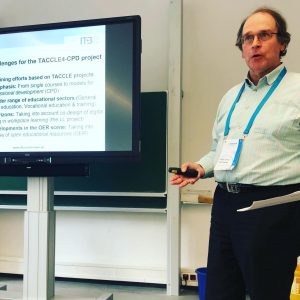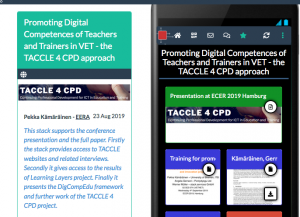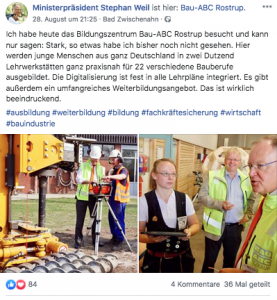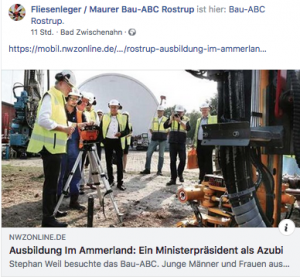Presenting the TACCLE 4 CPD project at ECER
I have already blogged about my preparation for the ECER 2019 conference in an earlier post. Now it was the time to present the message that I had prepared and to link it to the discussions in the conference. As I had mentioned in the earlier blog, the title of the paper was “Strategies and Training Models for promoting Digital Competences in the field of Vocational Education and Training”. The paper and the presentation focused on our work in the ongoing EU-funded project TACCLE 4 CPD. This project was mainly based on earlier projects that worked with teachers and promoted their competences to use digital tools and web resources in teaching (the TACCLE1, TACCLE2 and TACCLE3 projects). Concerning the field of vocational education training, the Learning Layers project could be seen as a similar predecessor project. BUT now the challenge for the TACCLE4 CPD project was to develop models for continuing professional development (CPD) – to enable schools and training providers to shape their own training.
For me the main challenge was to link this approach to current developments in the field of VET – to digital transformation (in work processes and occupations) and to digitization (at the level of working and learning tasks). From this perspective I introduced four parallel innovation paths regarding the focus on ‘whole curriculum’ solutions vs. introduction of particular approaches and new learning arrangements. As further illustration of my analyses and the resources I had used, I prepared an ePoster powered by the Learning Toolbox (see below).
During the conference I noted that some presenters introduced cases that also served as examples of the innovation paths that I had presented (see my next blog). Also, some presenters had done similar fieldwork on the role of trainers and had come to similar conclusions (see also my next blog). This was very rewarding and we were happy to share ideas. Here the fact that I had prepared the ePoster and that it could be accessed via mini-poster with QR-code (embedded into my presentation) and via direct link was very helpful.
Discussions on the neighbouring project TACCLE VET
In a further session my colleagues Graham Attwell (Pontydysgu), Fernando Marhuenda (University of Valencia) and Ludger Deitmer (ITB, University of Bremen) presented the work of the neighbouring project TACCLE VET.
Graham outlined a bigger picture of digital and ecological transformation in working life and possible implications for work, technology and occupations. He then continued to the work of UNESCO and the Joint Research Centre (JRC) of the European Commission to outline perspectives for promoting digital competences of educators. In particular he referred to the DigCompEdu framework of the JRC. Whilst these frameworks are in many respects helpful, they are very generic. From this point of view the project was doing fieldwork to get closer to the reality of vocational teachers and trainers.
Fernando continued by introducing the approach to fieldwork – the focus of different partners on their selected sectors and the mapping of interview partners’ digital competences. Based on the interviews the project is developing a framework that focuses on teachers’ competence areas – curriculum, pedagogy, resources and assessment. In this respect the project tries to develop a holistic and well-grounded view on promoting teachers’ digital competences.
Ludger gave specific insights into the challenges for promoting digital competences in the dual system of VET – with multiple learning venues (enterprise, school and intermediate training centre) and different actors. He illustrated this picture with results from a recent apprenticeship survey carried out by the trade union IG Metall in Bremen. This survey brought into picture gaps and shortcomings in teaching and training and a backlog in digitisation. As a contrast he then presented interim results from his interviews with vocational teachers and trainers who served as promoters of innovation in their organisations.
Here, in the discussion we could notice a complementary relation between the two TACCLE projects and their emphasis on innovation paths and addressing the competence areas of teachers and trainers. Also, when discussing the role of Open Educational Resources (OER) we noticed that a major need for training is related to copyright issues and to licensing. Whilst the tightened copyright rules are making teachers scary about using external resources, there is lack of knowledge on OER, different licenses and Open Access materials. From this perspective both TACCLE projects should address these issues.
—
I think this is enough of these sessions. In my next post I will discuss the sessions that gave me direct impulses for my work in the TACCLE4 CPD project.



